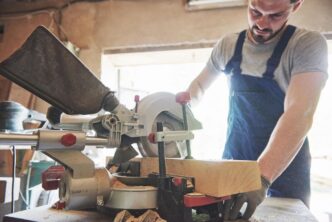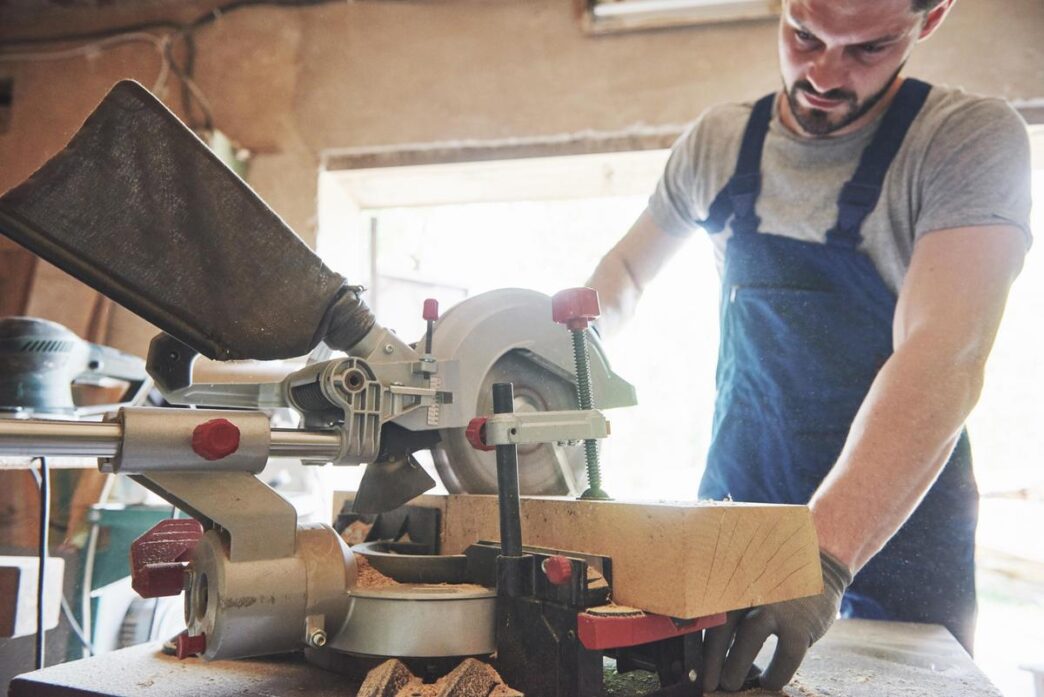Key Takeaways:
- Table saws cut large surfaces like plywood; miter saws make precise angle cuts for trim carpentry.
- Table saws are versatile for various cuts; miter saws focus on beveled edges with 8-12 inch blades.
- Miter saws are more portable (50-60 lbs) and precise; table saws are heavier (~300 lbs) and require more expertise.
- Table saws excel in versatility for large projects; miter saws are ideal for accuracy in trim work.
- Cost: Miter saws range from $100-$1,900; table saws from $200-$2,800. Miter saws simpler for beginners.
- Safety: Table saws pose higher risk; follow guidelines, use push sticks, keep work area clean.
- Maintain focus and follow safety practices to avoid injury.
Trying to decide between a table saw and a miter saw? Let’s dive into the core of these saws and find out which one suits your needs best. Understanding their key differences is the first step. We’ll look at their cutting capabilities, distinct features, and how they handle precision and portability. Whether you’re a DIY fanatic or a woodworking pro, choosing the right tool can transform your projects. Let’s find the tool that will work best for you!
What Are the Main Differences Between a Table Saw and a Miter Saw?
When deciding between a table saw and a miter saw, it’s essential to consider your project’s needs. How do table saws and miter saws differ in cutting capabilities? The main difference lies in their design; table saws cut large wood sheets, like plywood, thanks to their flat surface. On the other hand, miter saws are perfect for trim carpentry because they make precise angle cuts.
What are the significant features that differentiate these saws? Table saws have versatile blades, suitable for various cuts, including longer cuts. Miter saws, however, come with blades typically in 8-inch to 12-inch sizes to offer beveled edges. This makes them a go-to for detailed trim work, especially for beginners.
How do portability and precision vary between these tools? Miter saws lead in portability since they typically weigh around 50 to 60 pounds, making them easy to move. Table saws can be as heavy as 300 pounds and are often stationary. For precision, miter saws usually deliver cleaner cuts because the wood stays firmly against the saw. Table saws, requiring the wood to move, can result in less accurate results and pose a higher risk of injury. Understanding these key distinctions will guide you in choosing the right tool for your carpentry needs.
What Are the Benefits of Using a Table Saw?
A table saw is amazing for cutting large wood sheets. It holds big wood pieces with ease, so handling sheets like four-foot-by-eight-foot plywood is simple. Its flat table support keeps the wood in place, making sure the cut is clean and neat.
When you think of different cuts, the table saw shines again. It makes straight cuts, grooves, and even angled cuts with the right setup. While miter saws focus more on angles, a table saw is more diverse in the cuts it can produce.
The true strength of a table saw lies in its versatility. It’s suitable for many carpentry projects. From cabinets to furniture, this saw does it all. By changing the blade or angle, it can fit many needs, making it an all-around choice for woodworkers.
A table saw may require a bit of practice to master, but new woodworkers can benefit. Its wide range of uses helps develop different skills. Like any tool, safety is key, and full attention is needed when handling it. But once you get the hang of it, a table saw can be one of the most reliable tools in your workshop.
What Are the Benefits of Using a Miter Saw?
A miter saw is a key tool for those who need angled and beveled cuts. When asked, “How does a miter saw excel in making angled and bevel cuts?” The answer is, “It lets you cut angles with ease and keep them precise.” The miter saw’s blade swings left or right and can tilt in one direction. This makes it great for cutting precise angles.
Now, why is a miter saw preferred for trim carpentry? I would say, “Miter saws fit trim carpentry due to their accuracy and ease.” They are perfect for making precise cuts on small pieces of wood, often needed in trim work. When cutting baseboards, crown molding, or framing, having clean angles is a must. A table saw simply cannot match a miter saw in precision for these tasks.
On top of this, let’s look at what makes miter saws easily transportable for job sites. “Miter saws move easily due to their size and weight.” Most miter saws weigh between 50 and 60 pounds, making them simple to carry. This is very helpful for professionals who need to move their tools. Unlike heavy table saws, miter saws fit in the back of your car. This portability ensures the convenience required for various projects on different sites.
How to Choose Between a Table Saw and a Miter Saw?
What factors should influence your decision when buying a saw? First, consider precision needs. Miter saws excel in accuracy, great for fine cuts and angles. Meanwhile, table saws handle large wood pieces better due to their stable platform. Next, think about the kind of projects you plan to tackle. For instance, are you cutting large boards often, or focusing on trim work?
When is each saw type most suitable for home improvement projects? Miter saws are best for trim work and angled cuts. They shine in making clean beveled edges and corners. On the other hand, if you’re working with sheets of plywood or want to cut long boards, a table saw is ideal. Its flat surface supports the wood throughout the cut.
How do cost and skill level play into selecting the appropriate saw? Pricing varies widely. Basic miter saws start at $100, but can go up to $1,900. A table saw begins around $200, with high-end models reaching $2,800. Miter saws are easier for newbies because they require less skill for basic cuts. Table saws are more versatile, but they demand more expertise. Choose based on your budget and carpentry skill level. For extra input, visit this guide to saws for better understanding.
What Safety Tips Should Be Followed for Table Saws and Miter Saws?
When using a table saw, safety is key. Keep your fingers clear. Never wear loose clothes. Always use a push stick if the wood is small. Set the blade height so it’s just above the wood. Stay focused, and never rush your cuts.
Operating a miter saw also requires care. Fasten the wood securely. The blade should fully stop before you lift it. Eyes must stay protected with safety glasses. Make sure the area is clean from sawdust and small wood pieces.
Common errors cause many injuries. People often ignore safety guards. Others force wood through too quickly, risking kickback. Always follow manual guidelines for your machine. Learning from others’ mistakes can keep you safe.
Saws, especially table saws, can be risky tools. Reports show more injuries with these than miter saws. Risks decrease if you follow the right steps. Learn more about miter saws here.
By using a miter saw or table saw properly, you can enjoy carpentry work. Stick to these tips to avoid harm and keep projects fun. Each tool has its own safety needs, so stay informed. The right practice can make the difference between a mishap and a masterpiece.
Conclusion
In wrapping up, we’ve explored the key differences between table and miter saws. From cutting capabilities to features, each saw offers unique strengths. Table saws handle large wood sheets well, making them a versatile choice for woodworking. Miter saws excel at angled cuts, crucial for trim carpentry, and are easy to transport. Choosing between the two depends on your project needs and skill level. Remember, safety is non-negotiable for both tools. Understanding these aspects empowers you to pick the right saw and use it with confidence. Keep building, keep learning, and always prioritize safety.

